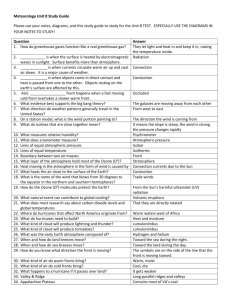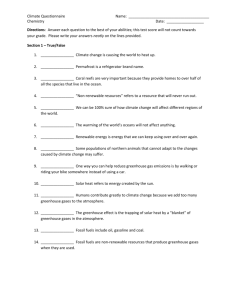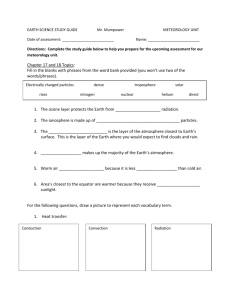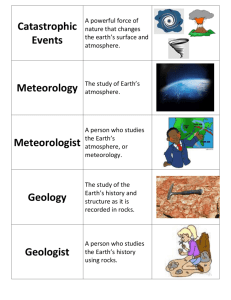File
advertisement
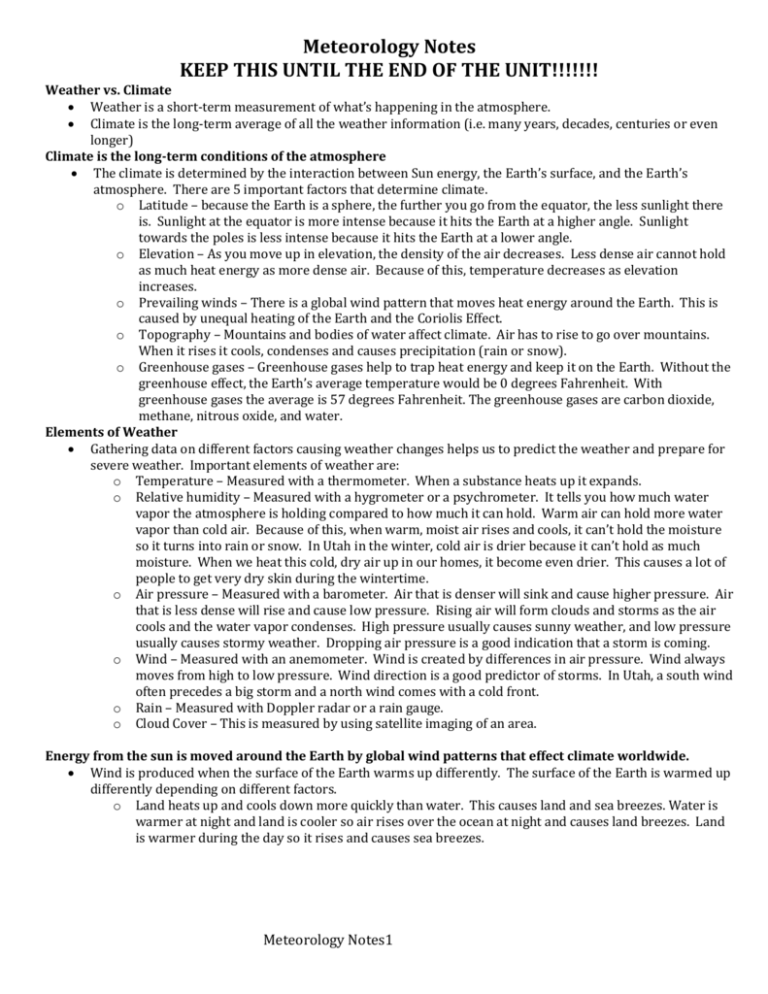
Meteorology Notes KEEP THIS UNTIL THE END OF THE UNIT!!!!!!! Weather vs. Climate Weather is a short-term measurement of what’s happening in the atmosphere. Climate is the long-term average of all the weather information (i.e. many years, decades, centuries or even longer) Climate is the long-term conditions of the atmosphere The climate is determined by the interaction between Sun energy, the Earth’s surface, and the Earth’s atmosphere. There are 5 important factors that determine climate. o Latitude – because the Earth is a sphere, the further you go from the equator, the less sunlight there is. Sunlight at the equator is more intense because it hits the Earth at a higher angle. Sunlight towards the poles is less intense because it hits the Earth at a lower angle. o Elevation – As you move up in elevation, the density of the air decreases. Less dense air cannot hold as much heat energy as more dense air. Because of this, temperature decreases as elevation increases. o Prevailing winds – There is a global wind pattern that moves heat energy around the Earth. This is caused by unequal heating of the Earth and the Coriolis Effect. o Topography – Mountains and bodies of water affect climate. Air has to rise to go over mountains. When it rises it cools, condenses and causes precipitation (rain or snow). o Greenhouse gases – Greenhouse gases help to trap heat energy and keep it on the Earth. Without the greenhouse effect, the Earth’s average temperature would be 0 degrees Fahrenheit. With greenhouse gases the average is 57 degrees Fahrenheit. The greenhouse gases are carbon dioxide, methane, nitrous oxide, and water. Elements of Weather Gathering data on different factors causing weather changes helps us to predict the weather and prepare for severe weather. Important elements of weather are: o Temperature – Measured with a thermometer. When a substance heats up it expands. o Relative humidity – Measured with a hygrometer or a psychrometer. It tells you how much water vapor the atmosphere is holding compared to how much it can hold. Warm air can hold more water vapor than cold air. Because of this, when warm, moist air rises and cools, it can’t hold the moisture so it turns into rain or snow. In Utah in the winter, cold air is drier because it can’t hold as much moisture. When we heat this cold, dry air up in our homes, it become even drier. This causes a lot of people to get very dry skin during the wintertime. o Air pressure – Measured with a barometer. Air that is denser will sink and cause higher pressure. Air that is less dense will rise and cause low pressure. Rising air will form clouds and storms as the air cools and the water vapor condenses. High pressure usually causes sunny weather, and low pressure usually causes stormy weather. Dropping air pressure is a good indication that a storm is coming. o Wind – Measured with an anemometer. Wind is created by differences in air pressure. Wind always moves from high to low pressure. Wind direction is a good predictor of storms. In Utah, a south wind often precedes a big storm and a north wind comes with a cold front. o Rain – Measured with Doppler radar or a rain gauge. o Cloud Cover – This is measured by using satellite imaging of an area. Energy from the sun is moved around the Earth by global wind patterns that effect climate worldwide. Wind is produced when the surface of the Earth warms up differently. The surface of the Earth is warmed up differently depending on different factors. o Land heats up and cools down more quickly than water. This causes land and sea breezes. Water is warmer at night and land is cooler so air rises over the ocean at night and causes land breezes. Land is warmer during the day so it rises and causes sea breezes. Meteorology Notes1 o The sun’s rays hit the Earth near the equator at a higher angle. This more intense sunlight will heat up the land more near the equator than near the poles. o Because the Earth is tilted, the angle of the sun’s rays hitting the Earth changes throughout the year. This is what causes the seasons. Climate Change • Past climate data is collected through geologic data including: o Sea floor studies: studying sediments in the sea floor can tell us about earth’s temperature over millions of years o Glaciers: Glaciers contain detailed records of temperature, snowfall, composition of the atmosphere, and debris (i.e. ash, dust, pollen, pollution etc.) o Tree rings: Trees usually add a ring to their trunk each year. By studying the size of the rings, we can learn about the conditions present when the ring was created. • Natural causes include: o Plate movement – Plates can move to different latitudes o Volcanic activity – ash from volcanoes can block sunlight o Changes in earth’s orbit – the shape of earth’s orbit changes, the tilt of the earth changes, and the earth wobbles as it orbits. o Changes in solar activity – the amount of energy coming from the sun can change. Scientists believe that a third of global climate change is due to an increase in solar radiation. • Human causes of climate change o Changing vegetation and ground cover. Concrete, asphalt, etc. absorb more sunlight and heat up more. o Increasing levels of greenhouse gases such as CO2 and methane traps more heat. Burning of fossil fuels has increased the level of CO2 significantly in the last 250 years. Meteorology Notes2 Feedback Loops Albedo- A measure of how reflective a surface is. A surface that reflects lots of light would have a high albedo while a surface that absorbs light will have a low albedo. o Example: Asphalt will have a low albedo, while concrete will have a higher albedo. That is why asphalt gets so hot in the summer because it absorbs lots of light that turns into heat. o Example: Snow will have a high albedo because it reflects lots of light. Dirt will have a lower albedo because it absorbs more light. There are two types of feedback loops: o Positive – These are unstable systems and can go out of control quickly – like Venus’ feedback loop shown below. We call this a runaway greenhouse effect. o Negative – These are stable systems that balance themselves. The Earth’s climate is a negative feedback loop that helps keep our climate stable enough to support life. Energy from the sun drives atmospheric processes Meteorology Notes3 When sunlight energy enters the atmosphere it can be either be reflected or absorbed. It can be reflected by the atmosphere or by the land. The atmosphere or the land can also absorb sunlight. We can compare Earth’s Energy to a financial budget. In order to balance a financial budget, the amount of money coming in must be equal to the amount of energy going out. You would not want to have money just disappear from your account, you must have every bit accounted for. The amount of energy coming in to our Earth must equal the amount going out. If more were coming in than was going out, we would be getting hotter and hotter. There is a balance between energy input and output as shown in the picture above. Greenhouse gases help trap heat. When Earth’s surface absorbs sunlight it heats up. Some heat from the surface is released as infrared light. Some of this light escapes to space but greenhouse gases trap some of the infrared light. The main greenhouse gases are carbon dioxide, methane, nitrous oxide, and water. Meteorology Notes4 The Earth’s atmosphere heats up through convection currents. Air near the surface of the Earth warms up and then rises. Cooler air higher in the atmosphere will then sink. Unequal heating of the Earth, combined with the Coriolis Effect causes the global wind pattern. o The Coriolis Effect happens because the Earth is spinning. The Coriolis Effect causes winds in the Northern Hemisphere to curve to the right. The global wind pattern helps us understand how heat energy and water is distributed throughout the Earth. This determines where desserts, rain forests, and other climates are. Here are some important principles to remember about this: Warm, moist air will rise and cool down. When moist air cools down, water will condense and produce rain and snow. When air sinks it will compress and heat up. Rising air usually produces rain/snow and sinking air usually produces clear air Rainforests happen on the Earth where warm, moist air rises and drops rain. This happens near the equator and at 60 degrees latitude. Deserts happen on Earth where dry air sinks and heats up through compression. This happens around 30 degrees latitude. Ozone is a molecule in the atmosphere that can have positive or negative affects Ozone is molecule composed of three oxygen atoms (O3). o In the lower atmosphere (troposphere), ozone is a pollutant. It can cause breathing problems. It is produced by car exhaust. It also causes metals to corrode more quickly. o In the upper atmosphere (stratosphere), it is good for us. It absorbs harmful UV rays that can cause cancer. o Meteorology Notes5 Air pressure systems bring predictable weather patterns o Low pressure systems – Low pressure systems are caused by rising air. As air rises, it sucks in air from the surroundings. This air curves to the right because of the Coriolis effect. Because of this, air will spin counter-clockwise around a low pressure. Rising air will cool, water vapor will condense, and cause clouds and storms. o High pressure systems – High pressure systems are caused by sinking air. As air sinks, it pushes air outward. This air curves to the right because of the Coriolis effect. Because of this, air will spin clockwise around a high pressure. Sinking air heats up so no clouds or storms will form. Wind will always blow from high pressure to low pressure. Conditions that cause severe weather Thunderstorms o Thunderstorms form when warm, moist air rises and then cools. o As it cools the water vapor condenses, then falls as heavy rain or hail. o Friction between ice crystals causes electrical charges that cause lightning. Tornados o Tornadoes form as dry, cool air collides with warm, moist air. o The cold air sinks and the warm air rises and starts to spin. o Tornadoes are common in the Midwest because cold air from the Canada combines with warm, moist air from the Gulf of Mexico. Hurricanes o Very warm oceans create very warm moist air that rises and creates very low pressures. o This low pressure sucks in more air – this causes very high winds. o The Coriolis effect causes them to spin counter clockwise. o A hurricane will strengthen while it’s over warm ocean water, but will weaken when it hits land, which has cooler, drier air. El Nino/ La Nina o El Nino is a weather pattern where the Pacific Ocean is warmer than usual. o El Nino causes warmer weather in the northern United States and cooler weather in the southern U.S. o La Nina is a weather pattern where the Pacific Ocean is cooler than usual. o La Nina causes cooler weather in the north and drier conditions in the south of the U.S. Air Masses and Fronts Air masses are large bodies of air with similar properties. These form usually over tropical regions or polar regions. There are four types of air masses. o Maritime Tropical air masses form over the ocean near the equator so they are warm and moist. o Maritime Polar air masses form over the ocean near the poles so they are cool and moist. o Continental Tropical air masses form over land near the equator so they are warm and dry. Meteorology Notes6 o Continental Polar air masses form over land near the poles so they are cool and dry. Weather fronts are boundaries between air masses. When different air masses collide, the warmer air will rise, cool and condense and form storms. o A cold front is when cold air passes underneath warmer air. The warm air will rise and form clouds and precipitation. Cold fronts usually produce stronger storms with high winds. o A warm front is when warm air passes over cooler air. The warm air will rise, form clouds and precipitation. Warm fronts usually produce rain, but not high winds. o A stationary front is a front that doesn’t move. o An occluded front is a when a cold front catches up to a warm front and they combine. This also produces stormy weather. On a weather map, symbols are used to represent each of these types of fronts. Evidence of global climate change • Geologic data from the past combined with current data show that the earth’s climate is warming. • Evidence of climate change: o Sea level rise – the sea level has risen 6.5 inches in the last century. o Average temperature worldwide has increased. Since 1880, the Earth has warmed significantly. Most of the warming has happened since 1970. Ten of the warmest years on record have happened in the last 12 years. o Warmer oceans – ocean temperature have risen 0.3 degrees Fahrenheit since 1970. o Shrinking ice sheets – This includes high mountain glaciers, ice sheets on land (like Greenland), and ocean ice (like the North pole). Greenland’s ice sheet lost 36 cubic miles of ice from 2002 – 2006. • Possible consequences of climate change and how it will impact humans o A decrease in ice – Many people depend on snow/glacier melt for drinking water. This can also affect the economy of places that depend on snow for skiing. o Increased likelihood of heat waves and droughts. This could cause food and water shortages. o Sea level rise will cause more flooding (like Hurricane Sandy and Katrina) in coastal cities. Almost half of the world’s population lives near the coast. o More intense hurricanes. The Carbon Cycle • Carbon is cycled through the earth’s different systems through various processes. o The carbon cycle provides carbon for building molecules important to living things such as carbohydrates, fats, and proteins. Plants take carbon dioxide from the atmosphere through photosynthesis. Carbon is stored in plants in the form of carbohydrates, fats and proteins. Carbon is passed to animals when they eat plants. Animals breathe out carbon dioxide through cellular respiration. Carbon is stored as fossil fuels when plants and animals die. Carbon is released as carbon dioxide when we burn fossil fuels. Carbon is stored in the ocean as carbon dioxide. This increases the acidity of oceans, which can affect ocean plants and animals negatively. • Processes that release carbon dioxide to the atmosphere are: o Respiration by plants and animals o Burning fossil fuels o Deforestation (burning forests for farming) o Decomposition of dead plants and animals • Processes that take carbon dioxide from the atmosphere and store it: o Photosynthesis by plants o Dead plants and animals store carbon as fossil fuels o Carbon dioxide is stored in limestone rocks. o Carbon dioxide dissolves in the ocean (increases the acidity of the ocean.) Meteorology Notes7 Natural resources from the atmosphere: Resource Renew Uses able? Solar Yes Electricity Wind Yes Electricity Hydroelectric Yes Electricity Pros Cons No pollution or greenhouse gasses, it will never run out (renewable) No pollution or greenhouse gasses, it will never run out (renewable) Expensive, low energy density, it’s not always sunny, can’t store it for a long time, Expensive, low energy density, it’s not always windy, can’t store it for a long time, can affect environment negatively Dams have a high environmental impact High energy density, already have technology Natural Hazards in Utah Human actions that contribute to the frequency, intensity and damage caused by hazard Starting wildfires, stopping wildfires allows fuel to build up so that when there is a fire it is much bigger, climate change could increase droughts, building homes in forests Building homes in flood planes or near rivers, climate change affects weather patterns Climate change is predicted to increase the severity of droughts Natural Hazard Wildfires Floods Drought Natural Hazard Hurricanes Tornadoes o Technology that helps us to predict when and where hazard will occur Satellites help us study weather patterns such as drought, lightning, etc. Water flow monitors Weather satellites help us study weather patterns Natural Hazards in other parts of the world Human actions that contribute to the frequency, Technology that helps us to predict intensity and damage caused by hazard when and where hazard will occur Climate change is predicted to increase the intensity Weather satellites, Doppler radar of hurricanes, building homes along coastlines Climate change is predicted to increase the intensity of tornadoes Weather satellites, Doppler radar Technological advances have helped us to gather more data, which helps us to better understand and predict how changes affect Earth’s systems. Satellite imaging helps us to observe large-scale changes like ice melting, cloud cover and weather systems. Meteorology Notes8

